Tangerine from a bone: how to plant and care?
Grow mandarin or lemon in childhood was tried by most of those who are fond of floriculture. And often they even received tender sprouts. But not everyone can grow at least a small tree. Often its leaves turn yellow and fall off. How to care for a tangerine so that it grows and even bears fruit at home?
Content:
- Description of the tangerine tree
- How to grow a tangerine from a seed?
- Houseplant Care Tips
- Mandarin vaccination: terms and rules
- Common Mandarin Leaders
Description of the tangerine tree
Together with oranges, grapefruits and their hybrids, the mandarin belongs to citrus fruits. They are distinguished by a soft, aromatic rind and a segmental structure of the fruit. It is an evergreen plant.
Now varieties have been bred for growing in an apartment or greenhouse.
They form a low, dense spherical bush. Mandarin leaves are elliptical, dense, leathery. Each of them lives for 4 years and then falls off. The flowers are white, fragrant.
The fruits are known to everyone for their taste and appearance. They are smaller than orange ones, contain less acids, and more water. The color ranges from orange to reddish. You can get them in our conditions only if you follow the rules of care. But even without fruit tangerine tree looks beautiful and will serve as a home decoration.
How to grow a tangerine from a seed?
Mandarins are grown from seed or by grafting. But you can eat homemade tangerines only 7 years after planting the seeds. The first fruits will be completely tasteless and odorless.
To get a harvest in the third year, you need to buy a grafted plant or vaccinate yourself. Growing a tangerine at home can be a fun process for the whole family. Start by sowing seeds.
Features of growing mandarin from seeds:
- Mandarins, like other citrus fruits, do not like acidic soil. It should not contain peat, which is found in most types of earthen mixtures. It dries quickly, and with increased watering it often turns sour. Therefore, it is not easy to find soil for tangerine in a store. You can take soil of neutral acidity. To cook it yourself, mix: leafy earth 2 hours, humus 2 hours, sod land 2 or 3 hours and sand 1 hour.
- The resulting mixture should be loose, good air permeability. If there are no components, add a glass to ordinary garden soil ash, a handful of superphosphate and a kilogram organic fertilizers... A small amount of clay will help the mixture retain moisture.
- The seeds are collected from ripe and undamaged fruits. Take about a dozen of them to choose the strongest plant. It is advisable to germinate the seeds before planting. To do this, they are placed in damp gauze and kept for several days. They make sure that they do not dry out, but you cannot fill them with water.
- In order not to constantly monitor, you can put the seeds in a special hydrogel purchased at a flower shop. It retains moisture and creates a comfortable environment for the seeds. It is even easier to plant seeds that are not germinated. In this case, they will germinate a little later.
- Prepare the dishes.This can be single cups, flower pots, or a shared box. A drainage layer is laid on the bottom. It can be made from coarse sand, fine expanded clay, crushed stone or charcoal.
- Seeds are sown 3 cm deep. Water, cover with a jar or polyethylene. Install in a warm place. There should be no poisonous plants (for example, oleander) nearby.
When sprouts appear on the surface of the soil, the dishes are transferred to light, but not under direct rays. The temperature in the room should be around 20 ° C. Periodically water the soil in pots, maintain high humidity. Watering is carried out with water, which has been defended for at least 3 days before.
Houseplant Care Tips
When the plants reach a height of 10 cm, they are transplanted into 4 liter pots. The soil is prepared in the same way as when planting seeds. The transplant is carried out by the transshipment method, having previously moistened the soil in the pot. Wherein root system practically not damaged.
A few days after the transplant, the tangerine is kept in a shaded place. Then set in the sun, but protect the leaves from the effects of scorching rays. Subsequent transplants are carried out once a year according to the same principle. The best time for this is late February or early March.
When the tree reaches the age of 8 years, transplant it after a year.
How to properly care for a tangerine tree:
- For successful growth, the tangerine tree needs a constant temperature regime. The minimum temperature is 14 ° C.
- The main problem when growing a tangerine tree is dry indoor air due to heating appliances. Therefore, every day the plant must be sprayed with heated water from a spray bottle. You can install a humidifier next to the tree. The mini-fountain, which is located near the tangerine, will decorate the interior and increase the humidity. Pallets with expanded clay filled with water will increase the air humidity.
- Daylight hours for the successful growth of a tangerine tree should be at least 12 hours. If it is not enough, it is illuminated with fluorescent lamps or a specially designed Reflax lamp.
- Watering should be done regularly and frequently in the spring and summer. In autumn and winter, the number and volume of irrigation are reduced. Water only as the soil dries up.
- Begin feeding the tangerine tree 2 weeks after the shoots emerge from the ground. Use a fertilizer specially designed for fertilizing citrus fruits, which is bought in flower shops. It could be: "Kemira Suite"," Sudarushka ". They are added at 2 g per liter of water. You can use Flumb horse manure concentrate. It is diluted 1:60. Fertilizer can only be applied to wet soil. Watering dry soil can cause root burns. No fertilization is applied in autumn and winter.
Mandarin vaccination: terms and rules
The tangerine tree is beautiful with its leaves. But many want to get fruit from it. To do this, the plant must be grafted from an adult fruiting tree. The best time frames for this are April, May and August. Then the period of sap flow passes.
Features of plant grafting:
- A plant is grafted, the trunk diameter of which has reached 6 mm. It can be not only tangerine, but also an orange or grapefruit. They purchase a scion, part of a one- or two-year-old branch of a fruiting tree, or a fresh eye. It can be purchased at some flower shops.
- A special budding knife is prepared. It will help you make an even and accurate cut. Prepare an elastic band such as a narrow medical patch and garden var... All instruments are sterilized, inoculation is carried out clean.
- At a height of 10 cm from the ground, a cut is made in the shape of the letter T. With a knife, the leaves are removed from the cutting, the bud is cut off together with a small bark shield. Insert into the incision so that the cut part fits snugly against the cambium rootstock.
- Tape to the trunk. The places where it does not fit tightly are covered with garden pitch. From above, the bush is covered with a jar or film.
After a month, the stock will begin to sprout. They begin to open the jar, airing the plant. Gradually increase the time that it spends without shelter. After 3 weeks, when it becomes clear that the bud has taken root, the trunk of the grafted tree is cut off slightly above the graft site. Cover the cut site with garden pitch. If the kidney is dry, the top is not cut off, the operation is repeated again. Establish a support to help the grafted tree grow vertically.
Common pests of mandarin
Mandarins are often affected by pests common to most houseplants:
- The false shield is brown oval insects covered with a durable shell. They secrete a sticky substance that closes the pores of the plant.
- Spider mites are small spiders that twine a thin web around the plant. Excretion of pests does not allow him to breathe.
- Citrus whitefly is a butterfly up to 3 mm long, whose wings are covered with a white waxy coating.
- Aphid - small black or green insects, gathering in groups on young shoots and leaves. Allocate a sticky bloom, drink plant juices.
All these insects are almost invisible to the eye. They are transferred from other indoor plants. They feed on their juices, multiply rapidly. As a result, the leaves lose their attractive appearance, then fall off. After that, the whole tree dies.
More information can be found in the video:
To prevent this, the plant is constantly examined. You can even use a magnifying glass. If pests are found, they urgently need to be destroyed. The spider mite is afraid of water, so the bush is washed under the shower, after covering the soil with plastic wrap.
Many pests are afraid of infusions of tobacco, garlic, onion skins.
If there are a lot of pests, and they cannot be destroyed by folk remedies, you need to use biological preparations:
- Fitoverm
- Actellic
They are not harmful to humans in the same way as chemical preparations, but they must be used according to the instructions. It is better not to spray with a working substance, but to rinse the leaves and stems with it. The lower part of the leaves, where pests are mainly collected, is especially actively washed. The processing is carried out 3 times with an interval of a week.
If small midges appear on the soil surface, this may indicate severe waterlogging. Their larvae can live in the ground, which damage the root system. To destroy them, the soil is loosened and treated with "Thunder 2". Growing a tangerine tree at home is not difficult. With constant care and attention, you can enjoy delicious aromatic fruits a few years after planting.



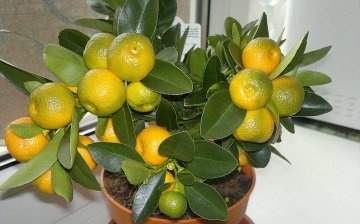

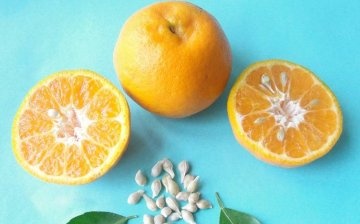
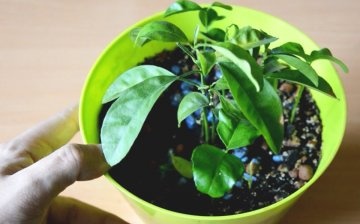
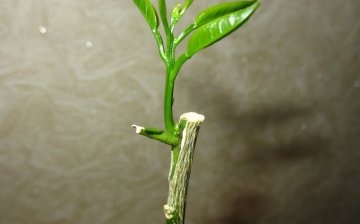
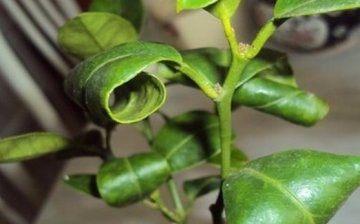






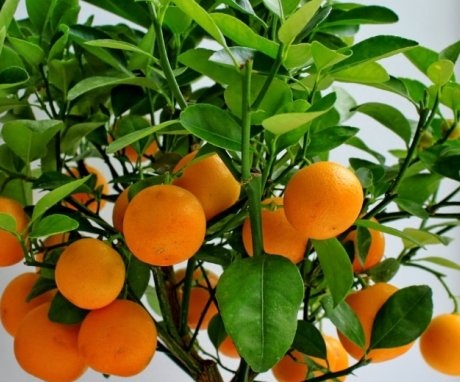
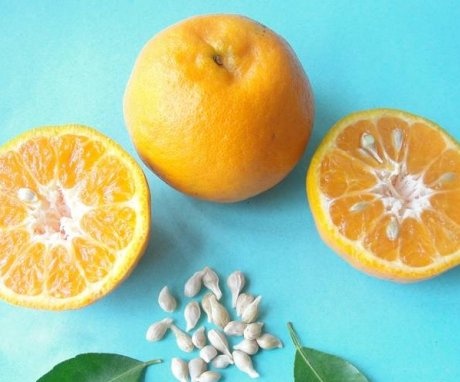
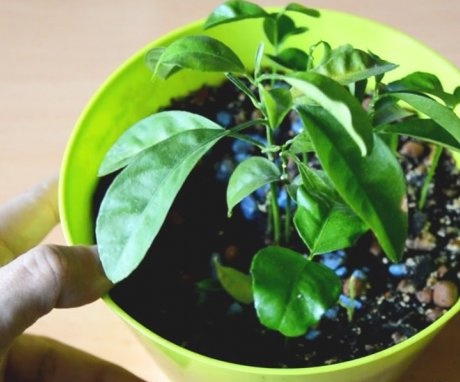


I really remembered my childhood. When I was still in school, I think I’ll throw a tangerine bone into a pot, sprinkle it with earth and grow a large palm tree) But it was not there. After a year, a small branch grew, and on it a couple of leaves. And after a short time it has dried up. Of course, now, after reading this article, you understand how much effort you need to make and how you need to look after in order to reap the benefits later.
And how many times I have not tried to grow a mandarin, orange or lemon from the seed, everything ended in vain. Namely, it grew to a small bush and either dried up or grew further, but did not bear fruit.
With us, on the contrary) Everything grew to a size that no longer fit into the planned place on the windowsill and did not bear fruit. After thinking, we were taken to the elevator to the first floor, as we live in cramped quarters.
I once tried to grow a lemon from a seed at home, I really didn't get anything, although the seed sprouted. Citrus fruits are very fond of aphids, she always attacks them.